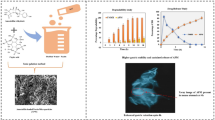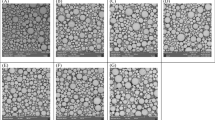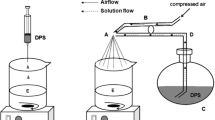Abstract
The objectives of the present investigation are (1) to screen the liquid and solid polyethylene glycol (PEG) molecules able to produce microparticles by cold or hot dispersion method either with or without other excipients, and (2) to evaluate the in vitro activities [like thermodegradation at three different storage conditions, dissolution using a membrane-free dissolution model in artificial tear fluid or phosphate buffer solution of pH 7.4, and zone-inhibition assay using Eschericella coli and red blood cells (RBC) rupturing assay] of azithromycin (AZM)-loaded microparticles in comparison to AZM alone. Adding chitosan and propylene glycol into PEG 6000 led to the formation of spherical-shaped microparticles. Keeping the drug alone in phosphate buffer solution of pH 7.4 at three different storage conditions did show degradation and thus precipitation whereas incorporating the drug into microparticles did not. The microparticles showed a drug release profile that was completely in a retarded style when compared to the release profile of drug alone. The antimicrobial activity of AZM was not affected after incorporating it into microparticles as shown in the zone-inhibition assay. Nevertheless, the microparticles reduced markedly the RBC rupturing property of the drug in comparison to drug in phosphate buffer solution of pH 7.4 (hemolysis percentage values of 27.41 ± 4.1and 43.11 ± 7.6, respectively). This indicates that the microparticles prepared based on PEG, chitosan and propylene glycol could be of a suitable carrier to protect AZM from thermodegradation, to provide retardation in drug release, to preserve antimicrobial activity, and to reduce RBC rupturing effect of the drug.





Similar content being viewed by others
References
Rowe RC, Sheskey PJ, Quinn ME. Handbook of pharmaceutical excipients. 6th ed. London: Pharmaceutical Press; 2009. p. 517–22.
Lowman AM, Morishita M, Peppas NA, Nagai T. Novel bioadhesive complexation networks for oral protein drug delivery. In: McCulloch I, Shalaby SW, editors. Materials for controlled release applications. Washington, DC: American Chemical Society; 1998. p. 156–64.
Mohl S, Winter G. Continuous release of Rh-interferon alpha-2a from triglyceride matrices. J Control Release. 2004;97(1):67–78.
Wu J, Ge Q, Mather PT. PEG-POSS multiblock polyurethanes: synthesis, characterization and hydrogel formation. Macromolecules. 2010;43:7637–49.
Morishita M, Goto T, Peppas NA, Joseph JI, Torjman MC, Munsick C, et al. Mucosal insulin delivery systems based on complexation polymer hydrogels: effect of particle size on insulin enteral absorption. J Control Release. 2004;97(1):67–78.
Morçöl T, Nagappan P, Nerenbaum L, Mitchell A, Bell SJ. Calcium phosphate-PEG-insulin-casein (CAPIC) particles as oral delivery systems for insulin. Int J Pharm. 2004;277(1–2):91–7.
Jaiswal J, Gupta SK, Kreuter J. Preparation of biodegradable cyclosporine nanoparticles by high-pressure emulsion-solvent evaporation process. J Control Release. 2004;96(1):169–78.
Jung SW, Jeong YI, Kim YH, Kim SH. Self-assembled polymeric nanoparticles of poly(ethylene glycol) grafted pullulan acetate as a novel drug carrier. Arch Pharmacol Res. 2004;27(5):562–9.
Peppas NA. Devices based on intelligent biopolymers for oral protein delivery. Int J Pharm. 2004;277(1–2):11–7.
Fiegel J, Fu H, Hanes J. Poly (ether-anhydride) dry powder aerosols for sustained drug delivery in the lungs. J Control Release. 2004;96(3):411–23.
Lueßen HL, Verhoef JC, Borchard G, Lehr CM, de Boer AG, Junginger HE. Mucoadhesive polymers in peroral peptide drug delivery: II. Carbomer and polycarbophil are potent inhibitors of the intestinal proteolytic enzyme trypsin. Pharm Res. 1995;12:1293–8.
Madsen F, Peppas NA. Complexation graft copolymer networks: swelling properties, calcium binding and proteolytic enzyme inhibition. Biomaterials. 1999;20:1701–8.
Bernkop-Schnürch A, Zarti H, Walker GF. Thiolation of polycarbophil enhances its inhibition of intestinal brush border membrane bound aminopeptidase N. J Pharm Sci. 2001;90:1907–14.
Harris JM, Martin NE, Modi M. 2001. Pegylation: a novel process for modifying pharmacokinetics. Clin Pharmacokinet. 2001;40:539–51.
Bhadra D, Bhadra S, Jain P, Jain NK. Pegnology: a review of PEG-ylated systems. Pharmazie. 2002;57:5–29.
Arguedas A, Soley C, Kamicker BJ, Jorgensen DM. Single-dose extended-release azithromycin versus a 10-day regimen of amoxicillin/clavulanate for the treatment of children with acute otitis media. Int J Infect Dis. 2011;15(4):e240–8.
Gillis RJ, Iglewski BH. Azithromycin retards Pseudomonas aeruginosa biofilm formation. J Clin Microbiol. 2004;42:5842–5.
Girard D, Bergeron JM, Milisen WB, Retsema JA. Comparison of azithromycin, roxithromycin, and cephalexin penetration kinetics in early and mature abscesses. J Antimicrob Chemother. 1993;31(Suppl E):17–28.
Sevillano D, Alou L, Aguilar L, Echevarría O, Giménez MJ, Prieto J. Azithromycin iv pharmacodynamic parameters predicting Streptococcus pneumoniae killing in epithelial lining fluid versus serum: an in vitro pharmacodynamic simulation. J Antimicrob Chemother. 2006;57(6):1128–33.
Bowman LM, Si E, Pang J, Archibald R, Friedlaender M. Development of a topical polymeric mucoadhesive ocular delivery system for azithromycin. J Ocul Pharmacol Ther. 2009;25(2):133–9.
Daebraker D, Visky D, Chepkwony HK, Van Schepdael A, Roets E, Hoogmartens J. Analysis of unknown compounds in azithromycin bulk samples with liquid chromatography coupled to ion trap mass spectrometry. Rapid Commun Mass Spectrom. 2003;17:342–50.
Kuehne JJ, Yu ALT, Holland G, Ramaswamy A, Taban R, Mondino BJ, et al. Corneal pharmacokinetics of topically applied azithromycin and clarithromycin. Am J Ophthalmol. 2004;138:547–53.
McHugh RC, Rice A, Sangha ND, McCarty MA, Utterback R, Rohrback JM, et al. A topical azithromycin preparation for the treatment of acne vulgaris and rosacea. J Dermatol Treat. 2004;15:295–302.
Rastogi R, Sultana Y, Ali A, Aqil M. Particulate and vesicular drug carriers in the management of tuberculosis. Curr Drug Deliv. 2006;3:121–8.
Paquette DW. Treating periodontal disease with local antimicrobials. Pract Proced Aesthet Dent. 2007;19:233–6.
Pijls RT, Cruysberg LP, Nuijts RM, Dias AA, Koole LH. Capacity and tolerance of a new device for ocular drug delivery. Int J Pharm. 2007;16(341):152–61.
Patel JK, Patel MM. Stomach specific anti-helicobacter pylori therapy: preparation and evaluation of amoxicillin-loaded chitosan mucoadhesive microspheres. Curr Drug Deliv. 2007;4:41–50.
Cochereau I, Meddeb-Ouertan A, Khairallah M, Amraoui A, Zaghloul K, Pop M, et al. 3-day treatment with azithromycin 1.5 % eye drops versus 7-day treatment with tobramycin 0.3 % for purulent bacterial conjunctivitis: multicentre, randomized and controlled trial in adults in children. Br J Ophthalmol. 2007;91:465–9.
Mohammadi G, Valizadeh H, Barzegar-Jalali M, Lotfipour F, Adibkia K, Milani M. Development of azithromycin-PLGA nanoparticles: physicochemical characterization and antibacterial effect against Salmonella typhi. Colloids Surf B Biointerfaces. 2010;80:34–9. doi:10.1016/j.colsurfb.2010.05.027.
Azhdarzadeh M, Lotfipour F, Zakeri-Milani P, Mohammadi G, Valizadeh H. Anti-bacterial performance of azithromycin nanoparticles as colloidal drug delivery system against different gram-negative and gram-positive bacteria. Adv Pharm Bull. 2012;2(1):17–24.
Tamilvanan S, Khanum R, Senthilkumar SR, Muthuraman M, Rajasekharan T. Studies on ocular and parenteral application potentials of azithromycin-loaded anionic, cationic and neutral-charged emulsions. Curr Drug Deliv. 2013;10(572–586):2013.
Kwiecień A, Krzek J, Biniek Ł. TLC-densitometric determination of azithromycin in pharmaceutical preparations. J Planar Chromatogr. 2008;21(3):177–81.
Tamilvanan S, Kumar BA. Influence of acetazolamide loading on the (in vitro) performances of non-phospholipid-based cationic nanosized emulsion in comparison with phospholipid-based anionic and neutral-charged nanosized emulsions. Drug Dev Ind Pharm. 2011;37:1003–15.
Moses RA. ADLER’S physiology of the eye clinical application. St. Louis, MO: The C.V. Mosby Company; 1981. p. 16–23.
Higuchi T. Mechanism of sustained-action medication: theoretical analysis of rate of release of solid drugs dispersed in solid matrices. J Pharm Sci. 1963;52:1145–9.
Shah MV, De Gennaro MD, Suryakasuma H. An evaluation of albumin microcapsules prepared using a multiple emulsion technique. J Microencapsul. 1987;4:223–38.
National Committee for Clinical Laboratory Standards. Methods for dilution antimicrobial susceptibility tests for bacteria that grow aerobically, Approved Standard M7-A5. 5th ed. Wayne, PA: NCCLS; 2000.
Jaromin A, Zarnowski R, Kozubek A. Emulsions of oil from Adenanthera pavonina L. seeds and their protective effects. Cell Mol Biol Lett. 2006;11:438–48.
Barratt G. Colloidal drug carriers: achievements and perspectives. CMLS Cell Mol Life Sci. 2003;60:21–37.
Lieberman HA, Riger MM, Banker GS, editors. Pharmaceutical dosage forms. Disperse systems, vol. 2. New York: Marcel Dekker Inc; 1998. p. 533–66.
Liu Z, Lv D, Liu S, Gong J, Wang D, Xiong M, et al. Alginic acid-coated chitosan nanoparticles loaded with legumain DNA vaccine: effect against breast cancer in mice. PLoS ONE. 2013;8(4):1–11. e60190.
Nagasaka Y, Ishii F. Interaction between erythrocytes from three different animals and emulsions prepared with various lecithins and oils. Colloids Surf B: Biointerfaces. 2001;22:141–7.
Jumaa M, Müller BW. Lipid emulsions as a novel system to reduce the hemolytic activity of lytic agents: mechanism of the protective effect. Eur J Pharm Sci. 2000;9:285–90.
Acknowledgments
The encouragement and support given by the managements of Lovely Professional University, Phagwara, Jalandhar, Punjab, India to perform this research work is acknowledged.
Conflict of Interest
The authors declare that they have no competing interests.
Author information
Authors and Affiliations
Corresponding author
Rights and permissions
About this article
Cite this article
Tamilvanan, S., Kumar, V., Sharma, D. et al. In vitro evaluation of polyethylene glycol based microparticles containing azithromycin. Drug Deliv. and Transl. Res. 4, 139–148 (2014). https://doi.org/10.1007/s13346-013-0187-2
Published:
Issue Date:
DOI: https://doi.org/10.1007/s13346-013-0187-2




